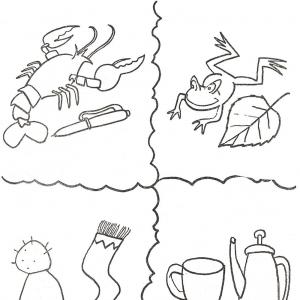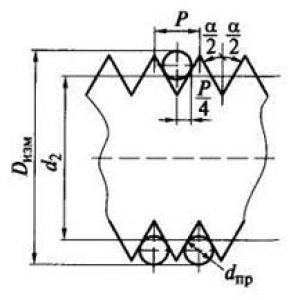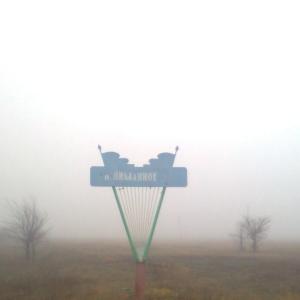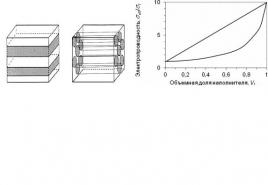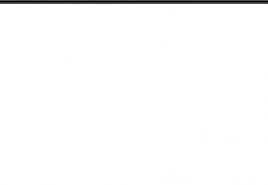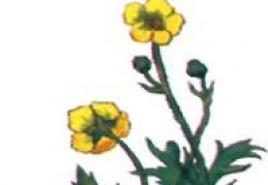The letters “ъ” and “ь”. Summary of a literacy lesson in the preparatory group “Introduction to the letter b b sign assignment for preschoolers
Lesson objectives:
- To form a desire to learn new things, to improve all types of speech activity of children (the ability to listen, express an opinion, read coherent texts highlighting the main idea in them).
- Develop phonemic hearing, memory, attention (cognitive processes).
- Build word reading skills with b- an indicator of the softness of consonant sounds; to make children realize that a soft sign does not mean a sound.
I. Organizational moment.
The bell rang loudly -
The lesson begins.
|Our ears are on top,
The eyes are wide open.
We listen, we remember,
We don't waste a minute.
II. Repetition of what has been covered. Updating knowledge.
What two groups are all letters divided into? (vowels and consonants).
What do you know about consonant sounds?
Why are some of them pronounced firmly and others softly?
When the letters I, E represent two sounds?
Why do you think some people are said to have a soft character, while others are said to have a strong character?
What is your character?
What else can you say “soft” or “hard” about, come up with a sentence.
III. Setting the topic and purpose of the lesson.
Above you, above me
A bag of water flew by
Ran into a distant forest -
Lost weight and disappeared (rain cloud)
- (A cloud is drawn on the board, drops in the shape of b). Here she is, a rain cloud, frowning and bursting into tears of rain.
A droplet broke away from the cloud and flew down. Rain dripped onto the ground, washing the young spring grass and the trees awakening from their winter sleep. One droplet flew into our class and sat on my palm. How small and tender she is. I won’t let her out and leave her in class, let her listen to how we can read, tell (I attach the drop model to the board).
Guys, I have only one drop, but there are many of you. What do we do? What should I do? Take some leaves and draw a drop of rain that our guest gave to everyone (everyone has a piece of paper on their desk, colored pencils, children draw a drop).
What letter do the water droplets look like? (on the b sign). Today in class we will talk about b sign - an indicator of the softness of consonant sounds.
IV. Working with new material.
1. Sound analysis of words.
Name the objects depicted ( goose, moose, pigeons, bullfinches, horse, bears). Look, remember the order (game "Day-Night"). What changed? (carry out 2-3 times). What two groups will we divide the objects into? (birds; animals). In each group, name the extra object (goose, horse). Why? (units). Choose which scheme the word goose belongs to. The word corresponds to the diagram.
How many syllables are there in a word? How did you find out? (as many vowels in a word, so many syllables).
What does the word consist of? (from the merger of a hard consonant with a vowel and a soft consonant behind the merger).
Make a word from the letters of the split alphabet (printed in printers).
How to formulate this word so that it is clear that the last sound must be pronounced softly? (put a sign, a letter that indicates the softness of the consonant sound).
This is what the helper letter serves for, which itself cannot speak and cannot be read in any way, but helps all the consonant letters that need it. Together with it, the consonants are read softly.
2. Introducing a new letter.
Letter R turned over -
She turned around with a soft sign.
(V. Stepanov)
Let's draw a soft sign
Gently, drop by drop, like this.
A droplet will soften the letter,
The word will sound softly.
(A. Shibaev).
Find where the letter is hidden (drawings on the board) (APPENDIX 1)
3. Reading from the board.
4. Reading texts with a soft sign (p. 138 of “Russian ABC”).
Where were the geese grazing? What did Petya do? What did they tell him? What does it mean to “stand up for yourself”?
Title the story (“Don’t tease the geese!”).
Repeated reading and analysis of what was read ( Tasks: read words with a soft sign; determine the softness of which sounds is indicated with its help; read words in which the softness of the consonant is indicated differently).
Children make up a story about how to take care of birds.
5. Game "Word or no word?"
Children read what is written on the board and explain the word or non-word they read.
| SALT | RUL | SEVEN | GUS | WHINING | TEN |
| CHAIR | DUST | SMOKE | SHEET | SEW | LINEN |
With explanation, “not words” turn into words.
6. Reading on p.136
How do you understand the word "hit"?
What other meaning could this word have? (it was frosty)
7. Development of attention and interest in the native language.
Soft sign, soft sign -
It’s impossible without him.
You can't write without it
Thirty, twenty, ten, five.
Instead of SIX we get SIX,
Instead of IS we get EAT.
They will become FOAM HEMP,
CORNERS - COALS,
BANKA will turn into a BANK.
This is what can happen
If we forget
Soft sign in words to write.
8. Conclusions from the lesson.
I am a magician. I want -
I will appear and transform
Chalk used for writing at school
Stranded, dangerous at sea.
Guess who the wizard is
Raise your hand higher!
V. Lesson summary (reflection).
What new things have you learned about consonant sounds? (a consonant sounds soft if the letter has a soft sign after it).
What role does the soft sign play in a word?
Summary of a speech therapy lesson on the topic: “The letter B.”
Goal: to reveal the peculiarity of using this letter.
Develop phonemic awareness through distinguishing between hard and soft phonemes. Develop skills in sound-letter and syllabic analysis. To consolidate the concepts of “sound - letter”, to develop in students stable skills in correctly writing words with a dividing solid sign. Develop cognitive processes
Develop phonemic hearing and speech. Cultivate a love for works of oral folk art.
Visual aids and handouts: notebooks, cards. Scene pictures.
During the classes.
1. Organizational moment.
During class, our eyes look carefully and everything……….(see)
Our ears listen carefully and everything…….(hear)
The head remembers and……(thinks)
II. Updating basic knowledge.
1. Introductory conversation.
What kind of children are in our class?
(On the board there are letters a, b, c, d, z, k, l, s, t, y, h. The teacher points to the letter, the children name words starting with this letter.)
A - neat.
B – cheerful.
B – cheerful.
D - kind.
Z – healthy.
K – beautiful.
L – inquisitive.
S – strong.
T – hardworking.
U - smart.
H - honest.
III. New material.
Guess the riddle.
There was a soft sign that was a little high...
The letters said strictly
: -Hey, bend over a little!-
And so he bent over, the eccentric,
Which turned into......a solid sign.
What do you think is the topic of our lesson today?
Today we will get acquainted with the letter “dividing solid sign”. This letter is the brother of the soft sign.
Fixing the optical image of a letter
What does the letter B look like?
Out of the bucket for a reason
Let's drink some water:
We need a ladle - a solid sign,
To avoid getting wet
Leaning on his long tail,
In the circus, the cobra stood up: - Sh-Sh-Sh-Sh...
I'm not threatening you
I make a strong sign.
Today we will get acquainted with letter "b". Let's find out in what cases this letter is written in words.
2. Introducing the letter.
Silent solid sign
It can't be pronounced!
But many words need it.
You will have to learn it:
Whether you want it or not
It's in the alphabet!
This is the letter “ъ” (show on the poster).
The letter Ъ is also called a tricky letter. Listen to the story about the boy Misha and the tricky letter Hard Sign. Why is she cunning?
Misha came home from school happy. He went into the kitchen, looked slyly at his mother and said: “I sat down and ate it!”
“Who did you have lunch with?” the mother was alarmed. “And I cooked and baked it!”
“I didn’t have lunch with anyone,” Misha said sadly. “I’m talking about something else. I sat down and ate it... Don’t you understand?”
“Why can’t we understand this?” said the grandfather. “Everything is clear: SEL is written without a hard sign, but EATED is written with a hard sign.”
“That’s right, grandfather!” Misha was delighted. “Today we went through the letter. A hard sign. A tricky letter - you can’t pronounce it like that, but without it you SAT, and with it you ate.”
Why is the letter B so tricky? (with its help one word turns into another).
Let's read the words in the diagram (on the board): entrance, exit, detour, entry.
What do these words have in common? (-ride- root).
3. Introducing the spelling rule for the dividing hard sign: the dividing hard sign is written after the hard consonant before the vowels i, e, e, yu.
Development of sound-letter word analysis skills
comparison of word schemes
ate-ate
How many letters? How many sounds? - Why did this happen: there are more letters than sounds? (Ъ does not indicate sound)
4. Development of phonemic awareness
Didactic game “Stone - cotton wool”.
Children raise a blue circle if they hear a hard consonant sound, and raise a green circle if they hear a soft sound.
Vocabulary material: leaves, entrance, skates, tulip, moved out, hemp, ate, announcement, blizzard, jam, shooting, pouring, rings, edible, loach, move out.
5. Work in notebooks.
6. Physical education minute.
Stand up together and stretch
Step around, spin around
Hands right, hands left, and then sit down boldly!
Stand up again, stretch
And smile at each other!
7. Reading the fairy tale by G. Yudin “How the Mouse went for cheese.” Remember the words with ъ in the fairy tale.
LIKE A MOUSE WENT FOR CHEESE
In the morning, the little mouse Mouse got on a tricycle and went to the store to buy cheese. As soon as I drove away from the house, I saw that the cat was lying down on the road and sleeping.
As soon as he drove up the hill, he saw that the cat had woken up. Stretching.
“I’ll sit under a bush for now,” thinks Mouse, “and eat a piece of cheese.”
He sat down and ate a piece. Then he ate some more, and some more. So he ate the whole piece around. There is a tiny piece left.
Eh! I just sat down and already ate everything... But I’d rather eat the cheese than the cat and the cheese.
9. Summing up the lesson. Reflection - How many letters do you now know that do not represent sounds? - What seemed the most difficult in the lesson? - What did you cope with the fastest? - What would you like to work on in the next lesson?
Write sentences with a hard separator.
The girl sat on a tree stump and ate the pie. The family is having lunch. The goat eats leaves from the bushes.
Write sentences with a hard separator.
The girl sat on a tree stump and ate the pie. The family is having lunch. The goat eats leaves from the bushes.
Write sentences with a hard separator.
The girl sat on a tree stump and ate the pie. The family is having lunch. The goat eats leaves from the bushes.
Write sentences with a hard separator.
The girl sat on a tree stump and ate the pie. The family is having lunch. The goat eats leaves from the bushes.
8. Come up with sentences with these words.
sat down, ate, rode, moved out, had lunch, ate, ate, ate
8. Come up with sentences with these words.
sat down, ate, rode, moved out, had lunch, ate, ate, ate
8. Come up with sentences with these words.
sat down, ate, rode, moved out, had lunch, ate, ate, ate
8. Come up with sentences with these words.
sat down, ate, rode, moved out, had lunch, ate, ate, ate
8. Come up with sentences with these words.
sat down, ate, rode, moved out, had lunch, ate, ate, ate
02.04 d/z. Learn
Swing for spiders.
On resinous spruce
New swing.
This is grandpa's spider
I hung them up:
Let the grandchildren swing
Mischievous little spiders.
02.04 d/z. Learn
Swing for spiders.
On resinous spruce
New swing.
This is grandpa's spider
I hung them up:
Let the grandchildren swing
Mischievous little spiders.
02.04 d/z. Learn
Swing for spiders.
On resinous spruce
New swing.
This is grandpa's spider
I hung them up:
Let the grandchildren swing
Mischievous little spiders.
02.04 d/z. Learn
Swing for spiders.
On resinous spruce
New swing.
This is grandpa's spider
I hung them up:
Let the grandchildren swing
Mischievous little spiders.
02.04 d/z. Learn
Swing for spiders.
On resinous spruce
New swing.
This is grandpa's spider
I hung them up:
Let the grandchildren swing
Mischievous little spiders.
02.04 d/z. Learn
Swing for spiders.
On resinous spruce
New swing.
This is grandpa's spider
I hung them up:
Let the grandchildren swing
Download -
The presentation includes videos about letters, poems, slides with writing letters, and coloring pages.
On slide 2 there is a video about a hard sign. We draw the child’s attention to the fact that b does not mean any sound. It is placed after the consonant letter, before the vowels e, e, yu, i.
On slide 3 there is a poem about what a letter looks like. Let the child come up with his own version. Write the letter in the album, draw it to the image.
On slide 4 there is a riddle poem. The child completes the missing words and finds words with a solid sign in the riddle.
On slide 5 there is a short poem that you can repeat from memory and find words with b. Print out the coloring book and shade the letter.
On slide 7 there is a video about a soft sign. Please pay attention to the child that b does not mean any sound. Make a sound analysis of the words “shadow” and “day”. These words have three sounds, but 4 letters. We put b at the end to show that the consonant is soft.
What does the letter b look like? On slide 8 is one of the options. Come up with your own options. Write the letter in the album, draw it to the image.
Read the poem on slide 9. Find words with b. Match with the pictures.
Read the poem on slide 9. How many times does b occur? Pay attention to the word “pouring”. In this word, b has a different role - it separates the vowel from the consonant. The separating soft sign is written after a consonant, before the vowels e, ё, yu, ya, i.
The letters “ъ” and “ь” do not indicate any sound. “b” shows that the consonant before it is soft (for example, in the words horse, day, skates, days). Also, “ъ” and “ь” can separate a consonant and a vowel (for example, in the words eat, entrance, family, pours).
Tinting of apartments and offices, tinting of building windows. The main benefit of tinting building windows is increased safety. Special films with anti-vandal properties give windows increased strength. Another plus is maintaining the required air temperature in the building. Tinted glass retains heat inside the building in winter and prevents the penetration of sunlight in summer. Our company, thanks to modern technologies, provides window tinting at any time of the year, since the film is applied to the inside of the glass. Window tinting will allow you to not be afraid of temperature changes and high humidity.
Games in pictures for children 4-5 years old
Assignments for children in the middle group of kindergarten on the topic “Learning to read”
Exercise 1
Name the items in each group. Match them with the letter their names begin with.
Task 2
What letter do these words start with? Complete the item whose name begins with the desired letter in each group.

Task 3
Connect objects whose names begin with the same letter.

Task 4
Connect objects whose names end with the same letter.

Task 5
Color the extra picture in each group. What letter do the names of the pictures begin with?

Task 6
Choose and color only those pictures whose names contain the letter “W”.

Task 7
Color only those objects that have the letter “L” in their names.

Task 8
Color only those objects whose names contain the letter “P”.

Task 9
Color only those objects that have the letter “K” in their names.

Task 10
Name the pictures. Connect them in a chain: in the first word - the name of the picture, the sound [M] is at the beginning of the word, in the second the sound [M] is in the middle of the word, in the third the sound [M] is at the end of the word.

Task 11
In the name of which object is the sound [D] heard, and which - the sound [T]?

Task 12
In the name of which object is the sound [B] heard, and which - the sound [P]?

Task 13
In the name of which object is the sound [Z] heard, and which - the sound [S]?

Task 14
Where is the sound [R] in words: at the beginning, in the middle or at the end of the word? Match the diagrams with the appropriate words.

Task 15
How many sounds are in each word - the name of the picture? Name them. Match the pictures with the correct numbers.

Task 16
What sounds do the names of these objects begin with? If you remove the first sounds in these names, you get different words. Which?
Check yourself.
Fishing rod - daughter; fly - ear; beads - mustache; thunderstorm - rose.

Task 17
Say the names of these objects. In which words does the first sound sound hard? Color the square next to this word blue. In which words does the first sound sound soft? Color the square green.

Task 18
Match each picture with the syllable with which its name begins.

Task 19
Combine words with one syllable with one square, words with two syllables with two squares, and words with three syllables with three squares.

Anna Inozemtseva
Lesson summary for the preparatory group “Introduction to the letters “b” and “b” sign”
Target: introduce letters"b" And "Kommersant" sign. Explain the meaning letters in words. Practice differentiating vowels and consonants. Practice sound analysis of words.
Progress of the lesson:
Guys, look at the board and tell me which ones letters we will meet you today?
Yes guys, today we are with you let's get acquainted with the letters, which do not indicate sounds, and practice finding these letters in words and text.
Now listen to me [a][t][t][l][l][s] what did I just say? (sounds)
Tell me please, can I see the sounds of speech? (no, we only hear and pronounce sounds).
What then can you see and write? (letters) .
Now I will show letters, and you must name the sounds that these letters stand for(demonstration letters) .
And now we will do an exercise « Letter - sound» . You will work in pairs, each pair goes to the board, one of the pair shows any letter, and the other must name the sound that the indicated one means letter, then we change.
Today we are with you let's get acquainted with the last two letters of our alphabet. This unusual letters. I'll tell you their secret. Let's remember what it is letter? (The letter is an icon, which replaces some sound and presents it to us). Letters with whom we are with you today let's get acquainted, also icons, but special ones. They do not represent sounds.
Fizminutka (stand in a circle)
Poor bear is sick
The bear ate a lot of honey (walk in a circle)
The bear cries and screams:
“My stomach hurts!” (turning the body left, right)
The bear is moaning and shedding tears
He has a stomach ache. (torso tilt to the right, left)
Naughty, greedy bear
I ate too many forest raspberries. (children wag their fingers)
(On board b) Children, look at the board, what is it like? letter? It's soft sign, he indicates that letter pronounced softly in front of him. Let's read the words that blackboard: ate, con, ban-ka. And if we add soft to these words sign, then we get a completely different word. Let's see what words will work out: spruce, horse, bathhouse.
If soft sign stands between a consonant and a vowel, then it will show that these sounds do not merge. Let's go back to the board and read words: seed - family, brothers - brothers, pour - pour, drink - drink.
The rain is pouring, the blizzard is blowing.
How do they do this?
This sign is trying,
It's called soft.
Pay attention to the board, there are words written here (day - shadow, away - night, sleep - again, ring - network). I will now read a poem, and you must finish it by choosing a word on the board.
Here he goes (day)
Coming (shadow)
The light is leaving... (away)
Coming... (night)
All the animals (sleep)
There will be a day (again)
Everything will be... (ring)
Golden… (net).
(On the board Kommersant) Children what is this? letter? This letter hard sign, stands only in the middle of a word and shows that the consonant sound does not merge with the vowel. Solid sign due to its nature, separates them.
Read the words: eat - ate - ate, exit - entry - entrance, sleep, sing, play, departure, detour, rise.
Soft sign and hard sign
We talked like this:
How many cakes did I eat?
Soft sign answered:
Well guys, we're done. get acquainted with the last letters of our alphabet. Now when you meet these letters in the text, you will know why they are there.
With which letters we met today?
What does soft indicate? sign?
What have we learned about solids? sign?

